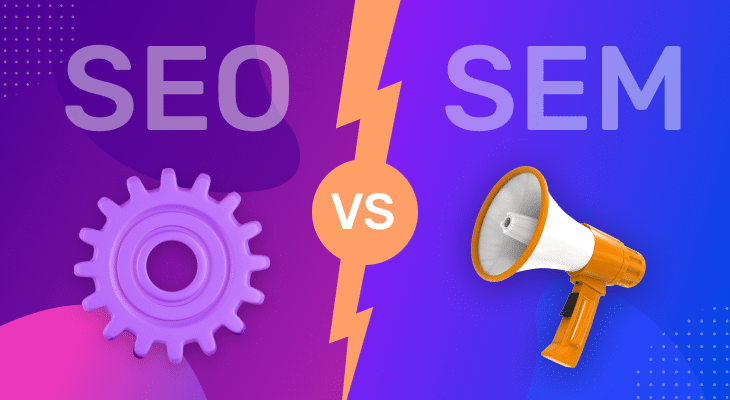SEO Vs. SEM – Which one Is Better For Your Business?

There are about 5.6 billion searches every day on Google according to a recent report byKenshoo. The sheer number of searches makes it challenging for you to find and attract a fair share of these searchers to your website or blog. However, following sound SEO (search engine optimization) and SEM (search engine marketing) practices could be beneficial.
While both are effective marketing channels, how are SEO and SEM different, you may ask? Well, SEO is coined for organic search ranking, whereas SEM is usually termed for paid ads. Either way, both help you drive traffic from search engines.
SEO or SEM? The choice between organic & paid search
SEM and SEO are marketing methods utilized to generate web traffic and brand awareness via search engines. SEO is part of SEM, but the latter also incorporates other marketing tactics like pay-per-click, more popularly known as PPC. Let’s understand them in detail.
What is SEO?
It a process to optimize a site to drive organic traffic from search results. Organic traffic is not paid, but you may need to spend money depending on your target market’s competitiveness. With SEO done right, you gain relevant visitors who show interest in buying your services or products.
SEO requires you to use appropriate keywords at the right places across your website and the content pieces you release on the internet to segment your audience.
What is SEM?
This method involves buying sponsored or paid ad listings to gain relevant search traffic. If we talk in a nutshell, SEM is similar to PPC marketing and advertising. The most popular PPC platform is Google Ads.
SEM helps advertisers boost visibility in search results and quickly attract the right type of traffic. To gain good ROI, you need to implement a dynamic and strong SEM strategy.
So, SEO or SEM?
SEO and SEM are both crucial to a business’s growth. Leveraging the combination of both can bring in outstanding results while improving your ROI. SEO can be utilized to boost your SERP (search engine results page) rankings and website optimization, whereas SEM can help in targeted advertising.
The Characteristics of a typical SEM campaign
An SEM campaign involves using online ads to gain search visibility. You can organize SEM campaigns in Bing Ads and Google Ads, and on social sites that permit advertising like Instagram and Facebook. Besides placing ads in search results, you can also include them in social media news feeds.
For an effective SEM campaign, you need to focus on your account, ad groups, and best practices. For instance, if you create an SEM strategy to promote a spa center, you should produce individual ad segments for each spa feature. Thus, you can manage one ad group for salon services, another for massage services, and so on.
An SEM campaign can deliver several benefits to your company, including impressive ROI, improved brand awareness and search engine visibility, high-quality traffic, increased sales, and more.
Typically, small and medium-sized companies spend up to $10,000 a month on their SEM strategy. Based on your needs, you can create a reasonable budget for your business.
The Characteristics of a typical SEO campaign
To implement an effective SEO campaign, you need excellent analytical attributes, good techniques, and consistency. Ensure your campaign includes the following elements:

-
Valuable web content
Original and useful web content will continue to draw traffic even if search algorithms change. It boosts your site’s credibility and establishes you as an authority on the topic. Therefore, focus on creating original content, and update it regularly.
Search platform spiders scour the internet for particular keywords. Your content can rank in SERPs when it has the keywords that users search.
-
Backlinks
More than number, the quality of backlinks is essential. So, you should aim to get links from related and relevant sites that have high search rankings.
You can utilize the following methods to acquire quality backlinks:
- Video marketing
- Infographic marketing
- Quality comments on blogs
- Guest blogging
- Content marketing

Social activities (social following, shares, and mentions)
Social media marketing is now a prominent part of SEO. It can help engage with the audience, enhance online reputation, and generate links.
Search engine algorithms also give importance to social media platforms. If your content is shared and talked about on leading social platforms, search engines will provide it with greater authority, boosting your ranking.
Map your needs & relevant resources
Now that you know the characteristics and benefits of SEO and SEM, you can select the right one for your business. To do it right, you need to identify your needs and resources. Here are some factors that can help you in the process –
- Understand customer needs: Customer is the key to business growth. So, comprehend their needs and demands first. You can then plan your SEO and SEM campaigns in a way that helps you meet your users’ requirements. Once you succeed in doing this, you can ensure long-term customer retention benefits.

- Consider user buying patterns: For this, you will require analyzing your user data. Determine their buying patterns and show up right where they cannot resist your services. For instance, you can segment your customers based on their purchase behavior – are they likely to buy from promotions over email, ads on websites they frequently visit, via messaging / call, or other ways.
- Analyze your competitors: Evaluate your competitors’ organic and paid campaigns’ effectiveness and check what more you can do to beat them. Run their keyword analysis and try to use the high search volume keywords to gain more traction.
- Evaluate your website: Check where your site rankings stand. Based on that, you can further plan your SEO strategies and SEM methods. Determine what will provide you with long-term gains, and give it a shot. For instance, if you can boost your traffic or revenue with organic SEO, think twice before you shell out your budget on paid SEM campaigns.
Wrapping Up
There is no magic formula that derives which is better for your business – SEO or SEM. All you have to do is evaluate your marketing efforts, try-and-test different strategies, and leverage those that bring you extraordinary results. While SEO would be beneficial for some companies, others might see their growth with SEM. At times, a good balance of both also proves advantageous. So, be wise while you make your choice!

